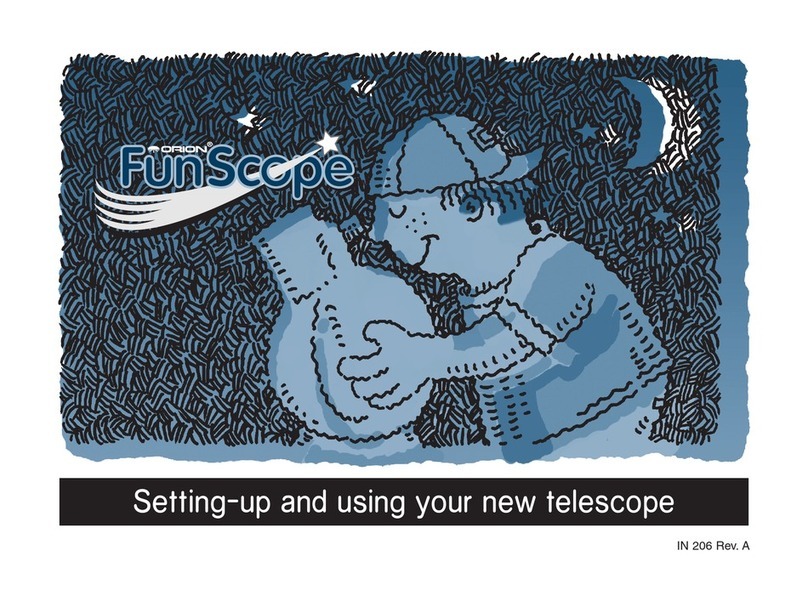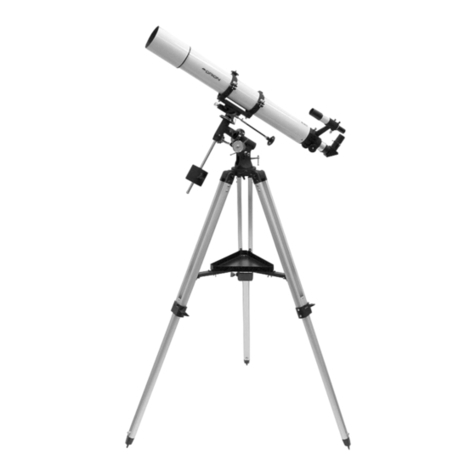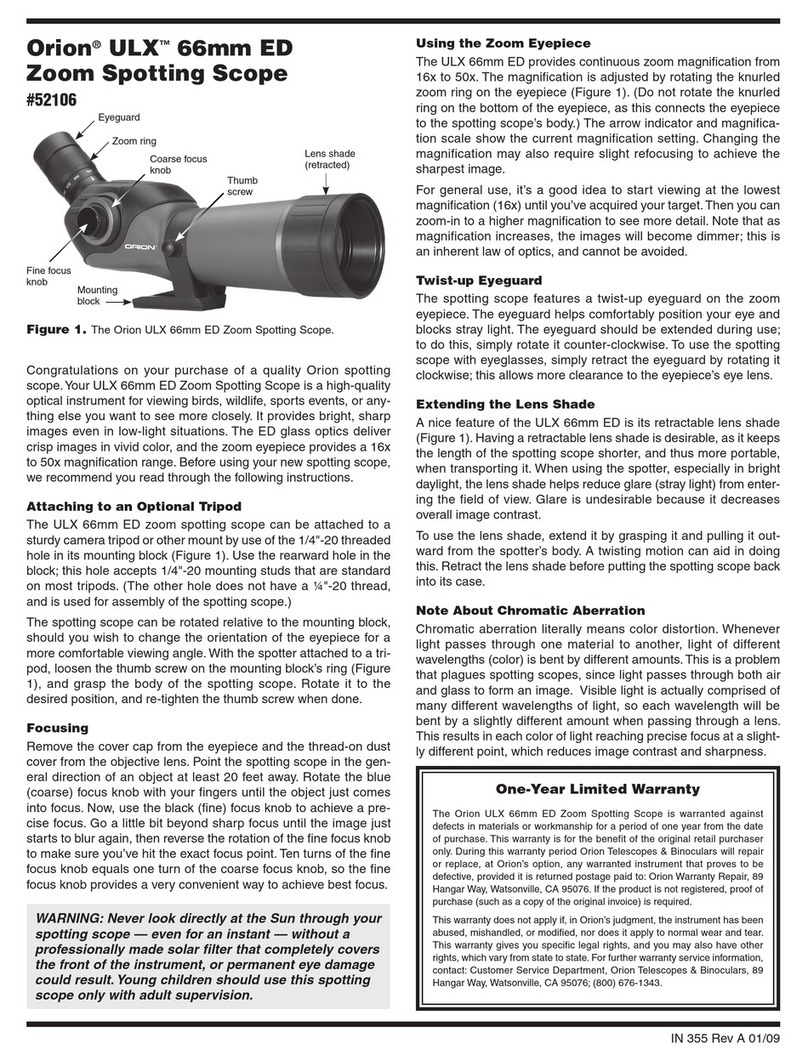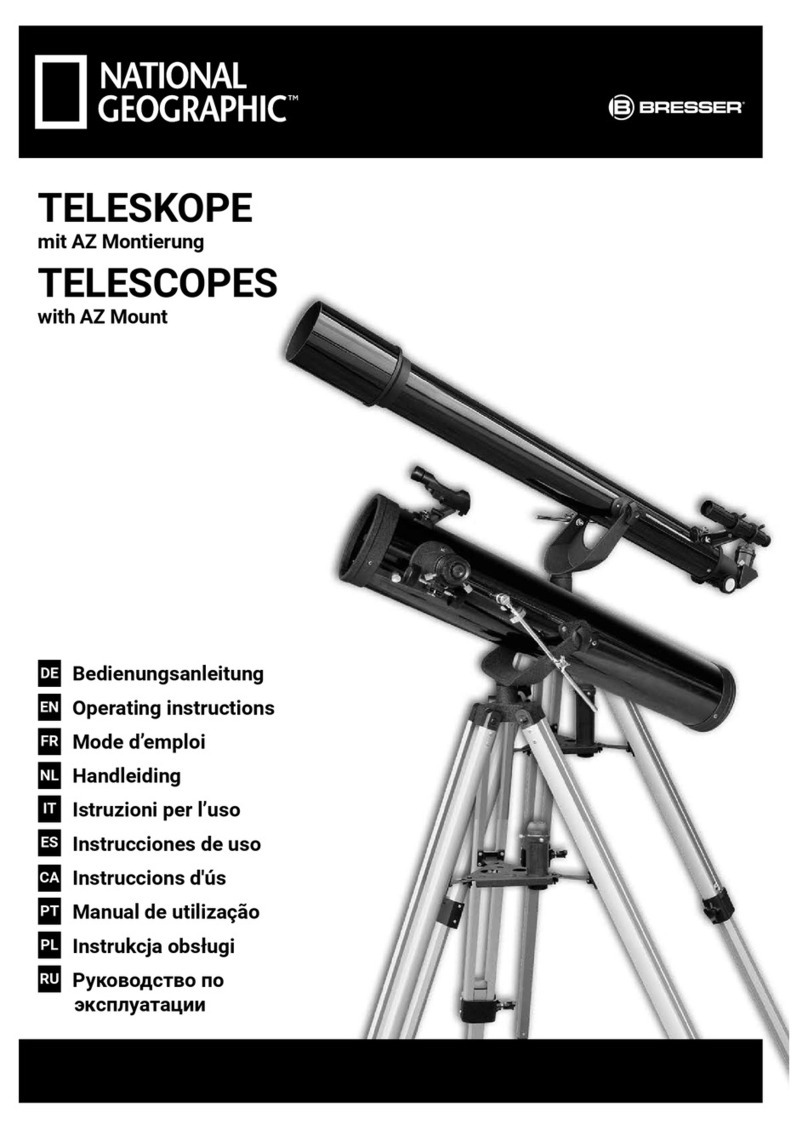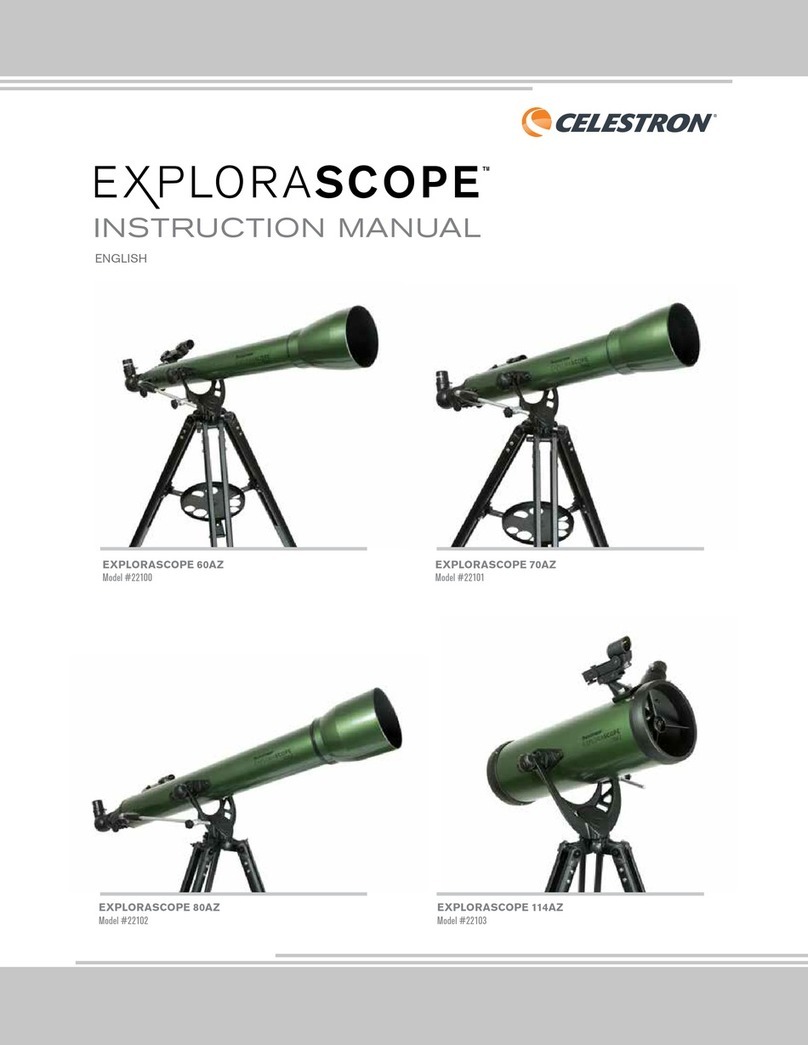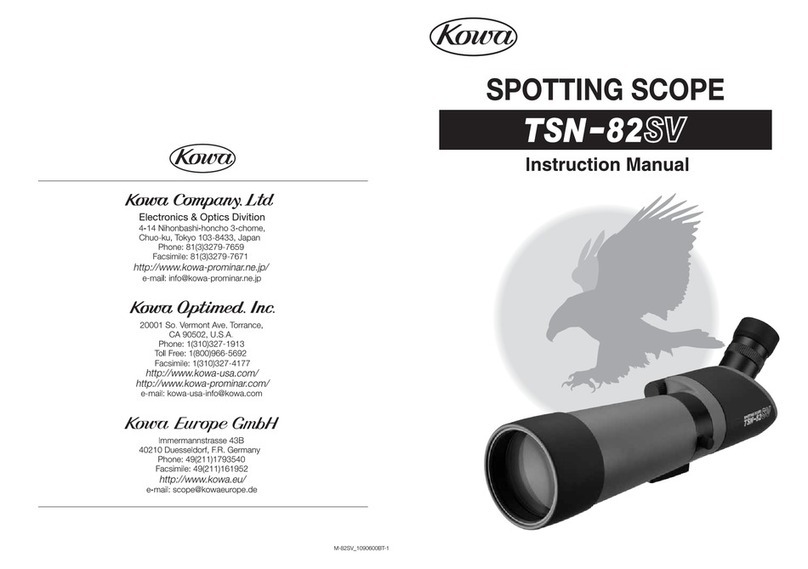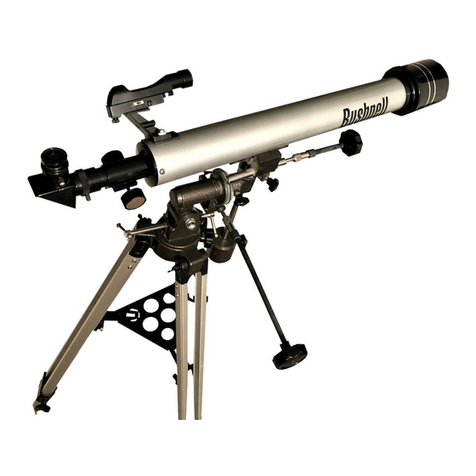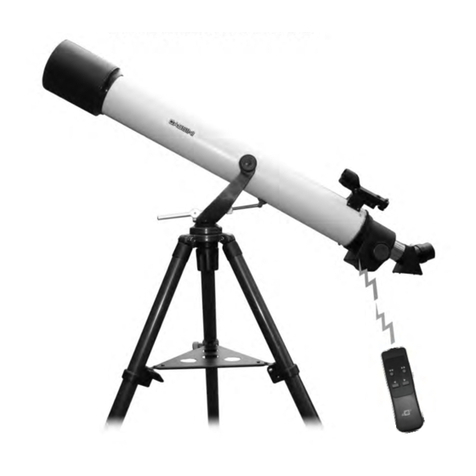Explore One CF350 User manual

CF350 TELESCOPE
88-10052CF
1
50 mm Telescope w/ AZ Table Top Mount
Instruction Manual
SUN HAZARD
— Never look directly at the sun
with this device.
WARNING:
CHOKING HAZARD
— Small parts.
Not for children under 3 years.
WARNING:
AGES
8
++
Specifications
Optical Design
Magnification
Front Lens (clear aperture)
Focal Length
Standard Eyepieces
Finish
Tripod
Achromatic Refractor
17.5 - 28x
50 mm
350 mm
0.965” 12.5mm & 20mm
Silver Carbon Fiber
Table Top

2
Customer Service: Call 1-866-252-3811
WARNING: NEVER ATTEMPT TO OBSERVE THE SUN WITH THIS DEVICE!
OBSERVING THE SUN – EVEN FOR A MOMENT – WILL CAUSE INSTANT AND
IRREVERSIBLE DAMAGE TO YOUR EYE OR EVEN BLINDNESS. Eye damage is often
painless, so there is no warning to the observer that the damage has occurred until it
is too late. Do not point the device at or near the Sun. Do not look through the device
as it is moving. Children should always have adult supervision while observing.
SUN WARNING
Instruction Manual, &
Downloadable Planisphere Visit:
www.exploreone.com/pages/product-manuals
SAFETY WARNINGS
• RESPECT PRIVACY: WHEN
USING THIS DEVICE,
RESPECT THE PRIVACY
OF OTHER PEOPLE. FOR
EXAMPLE, DO NOT USE
THEM TO LOOK INTO
PEOPLE’S HOMES.
• CHOKING HAZARD:
CHILDREN SHOULD ONLY
USE DEVICE UNDER ADULT
SUPERVISION. KEEP
PACKAGING MATERIALS
LIKE PLASTIC BAGS AND
RUBBER BANDS OUT OF
THE REACH OF CHILDREN
AS THESE MATERIALS
POSE A CHOKING HAZARD.
• RISK OF BLINDNESS:
NEVER USE THIS DEVICE
TO LOOK DIRECTLY AT
THE SUN OR IN THE
DIRECT PROXIMITY OF
THE SUN. DOING SO MAY
RESULT IN A PERMANENT
LOSS OF VISION.
• RISK OF FIRE: DO
NOT PLACE DEVICE,
PARTICULARLY THE
LENSES, IN DIRECT
SUNLIGHT. THE
CONCENTRATION OF
LIGHT RAYS COULD
CAUSE A FIRE.
• DO NOT DISASSEMBLE
THIS DEVICE. IN THE
EVENT OF A DEFECT,
PLEASE CONTACT YOUR
DEALER. THE DEALER
WILL CONTACT THE
CUSTOMER SERVICE
DEPARTMENT AND
CAN SEND THE DEVICE
IN TO BE REPAIRED
IF NECESSARY.
• DO NOT SUBJECT
THE DEVICE TO
TEMPERATURES
EXCEEDING 60° C 140° F.
• DISPOSAL: KEEP
PACKAGING MATERIALS,
LIKE PLASTIC BAGS
AND RUBBER BANDS,
AWAY FROM CHILDREN
AS THEY A POSE A
RISK OF SUFFOCATION.
DISPOSE OF PACKAGING
MATERIALS AS LEGALLY
REQUIRED. CONSULT
THE LOCAL AUTHORITY
ON THE MATTER IF
NECESSARY AND
RECYCLE MATERIALS
WHEN POSSIBLE.
Read and follow the instructions, safety rules, and first aid information.

3
Parts Overview
1. 50mm Objective Lens
2. Table Top Alt-Azimuth Tripod
3. Optical Tube Assembly (OTA) with Dew Shield
4. Focus Wheel
5. Diagonal
6. 0.965” Eyepieces (12.5mm and 20mm)
1
2
5 6
4
3
How To Set Up
Assembly:
Note: We recommend assembling your telescope for the first time in the daylight or in a lit room so that you can familiarize
yourself with assembly steps and all components.
• Open the tripod on a stable surface until the tripod spreaders are fully extended.
• Attach the telescope tube to the tripod head using the locating screw for altitude.
• Insert the diagonal into the focuser and secure it by tightening the thumbscrews.
• Place your chosen eyepiece into the diagonal. We recommend starting with the 20mm because it will
provide the widest field of view.

4
Telescope Terms To Know:
Diagonal: A mirror that deflects the ray of light 90 degrees.
With a horizontal telescope tube, this device deflects the light upwards so
that you can comfortably observe by looking downwards into the eyepiece.
The image in a diagonal mirror appears upright, but rotated around its
vertical axis (mirror image).
Focal length: Everything that magnifies an object via an optic lens has a certain focal length. The focal
length is the length of the path the light travels from the surface of the lens to its focal point. The focal
point is also referred to as the focus. In focus, the image is clear. In the case of a telescope, the focal
length of the telescope tube and the eyepieces are used to determine magnification.
Lens: The lens turns the light that falls on it around in such a way so that the light gives a clear image in
the focal point after it has traveled a certain distance (focal length).
Eyepiece: An eyepiece is a system made for your eye and comprised of one or more lenses. In an
eyepiece, the clear image that is generated in the focal point of a lens is captured and magnified still
more.
Magnification: The magnification corresponds to the difference between observation with the naked
eye and observation through a magnifying device like a telescope. If a telescope configuration has a
magnification of 30x, then an object viewed through the telescope will appear 30 times larger than it
would with the naked eye. To calculate the magnification of your telescope setup, divide the focal length
of the telescope tube by the focal length of the eyepiece.
NOTE:
The magnifying power of a telescope is determined by dividing the focal length of the telescope by
the focal length of the eyepiece. This means that as the focal length of your eyepiece increases, the
magnifying power decreases.
Using Your Telescope:
After you have assembled your telescope, you are ready to start observing. Put the 20mm eyepiece
into the diagonal to get the widest field of view. This wider field of view will make it easier to locate
and track objects.
To move the scope up, down and side to side, loosen the locking screws slightly and grip the telescope
near where the tube meets the focuser and steadily move the tube until your target comes into view
in the eyepiece. Once you have found and focused on your desired target, you can lock the telescope
into position by tightening the two locating screws. It is important to remember that the rotation of the
Earth means objects will move out of your eyepiece fairly quickly.
For a closer look at an object, you can insert the 12.5mm eyepiece. The magnification will increase
from 18x to 28x.
Cleaning:
Your telescope is a precision optical device and keeping the optics free of dust and dirt is crucial for
optimal performance. To clean the lenses (objective and eyepiece) use only a photo-grade soft brush
or a lint-free cloth, like a microfiber cloth. Do not press down too hard while cleaning, as this might

5
scratch the lens. Ask your parents to help if your telescope is really dirty. If necessary, the cleaning
cloth can be moistened with an optical glass cleaning fluid and the lens wiped clean using very little
pressure. Do not use harsh detergents!
Make sure your telescope is always protected against dust and dirt.
After use, leave it in a warm room to dry off before storing.
Possible Objects For Observation:
Terrestrial Objects
Take note of the examples below, including Mount Rushmore and the golf course. Start with the 20
mm eyepiece and focus until the image is clear. After mastering the 20 mm eyepiece, switch to the 12.5
mm eyepiece and practice scanning and focusing until the image is clear. Choose several terrestrial
objects to practice focusing on, but never point your telescope at or near the sun, or you risk blindness.
The Moon
Diameter: 3,476 km
Distance: Approximately 384,401 km
The Moon is the Earth’s only natural satellite, and it is the second brightest object in the sky (after the
Sun). Although it is our closest neighbor, a lot of people have never really taken a good long like at the
Moon. With your telescope, you should be able to see several interesting lunar features. These include
lunar maria, which appear as vast plains, and some of the larger craters. The best views will be found
along the terminator, which is the edge where the visible and cloaked portions of the Moon meet.
f=20 mm f=12.5 mm
The Moon
f=20 mm f=12.5 mm
Terrestrial Images

6
Orion Nebula:
Right ascension: 05: 35.4 (hours: minutes)
Declination: -05: 27 (degrees: minutes)
Distance: Approximately 1,344 light years
The Orion Nebula is a vast star-forming region located in the “sword” branching off of the famous
Orion’s Belt. Also known as Messier 42, this diffuse nebula is bright enough to see with the unaided eye
— although it will only appear as a slightly foggy star. However, with your telescope, you can see many
of the beautiful details, such as the billowing clouds of gas and dust where new stars are being born.
Pleiades Star Cluster:
Right ascension: 03: 47.0 (hours: minutes)
Declination: +24: 07 (degrees: minutes)
Distance: Approximately 444 light years
The Pleiades Star Cluster is a group of brilliant blue stars located in the Taurus Constellation.
Also known as Messier 45 or “Seven Sisters”, this open star cluster consists of more than 1,000
confirmed stars, although an average of only six are visible to the unaided eye. With your telescope,
you can quickly reveal some of the more elusive members of this legendary and beautiful cluster.
Andromeda Galaxy:
Right ascension: 00: 42.7 (hours: minutes)
Declination: +41: 16 (degrees: minutes)
Distance: Approximately 2.54 million light years
The Andromeda Galaxy is the closest major galaxy to our own Milky Way. Also known as Messier
31, this famous spiral galaxy is part of the Local Group of galaxies. Although it is technically bright
enough to see with the unaided eye under a very dark sky, your telescope may show its bright center,
hints of its spiral structure and its much smaller companion galaxies known as M32 and M110.
Troubleshooting Guide:
Problem Solution
No picture Remove dust protection cap and sun-shield from the objective opening.
Blurred picture Adjust focus using focus ring.
No focus possible Wait for temperature to balance out.
Bad quality Never observe through a glass surface such as a window.
Viewing object visible in the finder, but not
through the telescope Align finder to telescope (see instructions)
Despite using star diagonal prism the picture is
“crooked” The star diagonal prism should be vertical in the eyepiece connection.

7
NOTES:

8
© 2017 Explore Scientific®, LLC.
1010 S 48th Street, Springdale, AR 72762
exploreone.com | 866.252.3811
All rights reserved. Made in China.
CONFORMS TO THE SAFETY
REQUIREMENTS OF ASTM F963
Table of contents
Other Explore One Telescope manuals
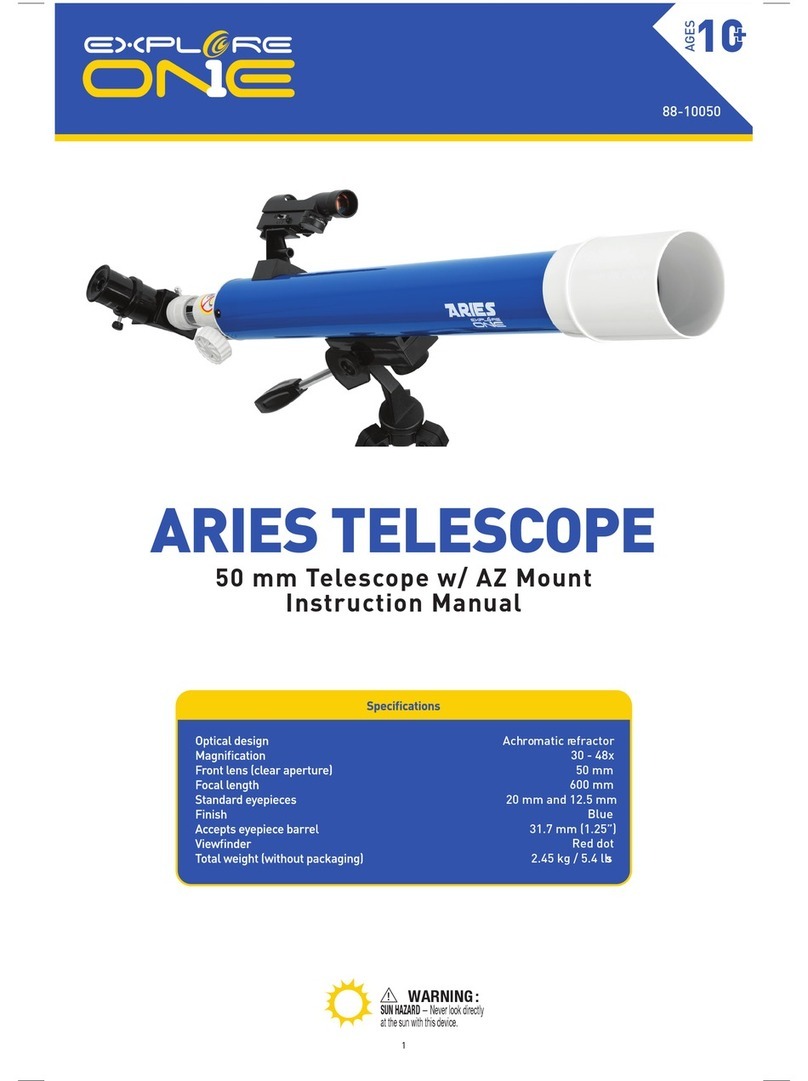
Explore One
Explore One ARIES 88-10050 User manual
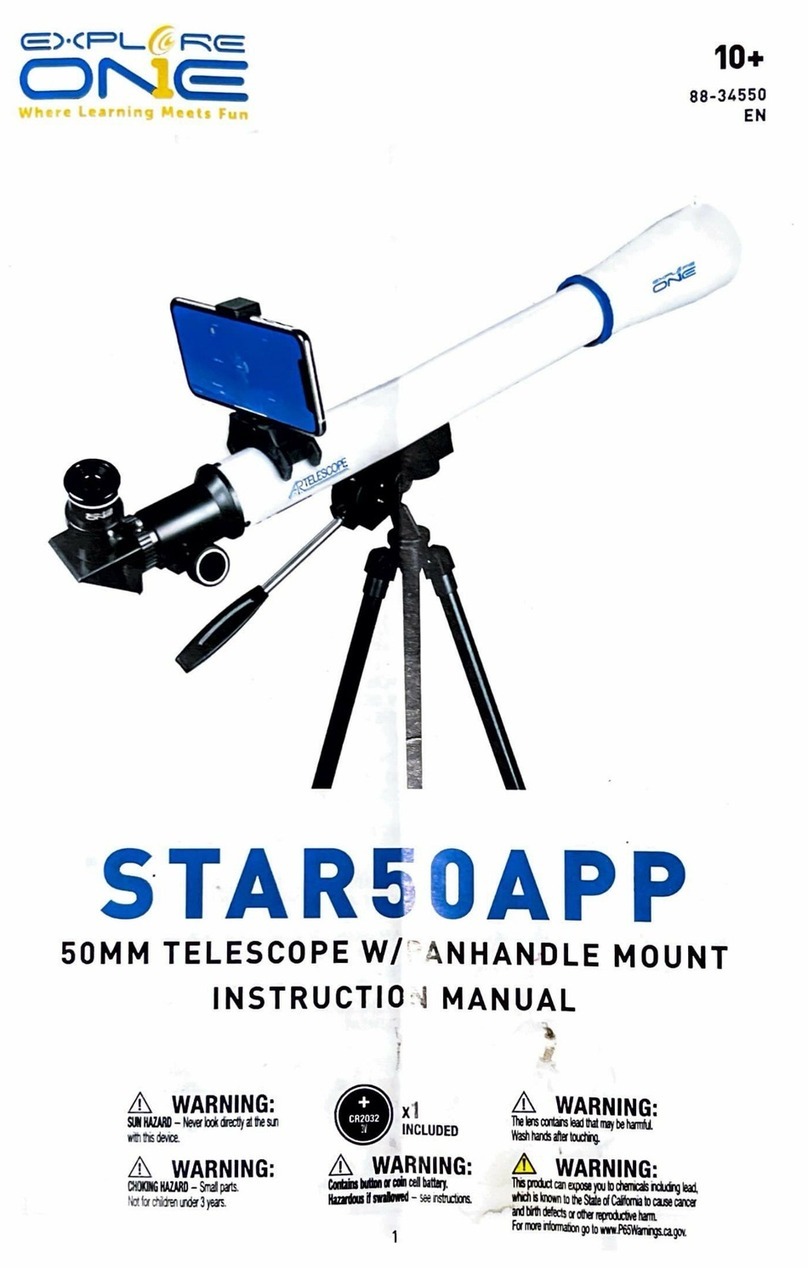
Explore One
Explore One STAR50APP User manual
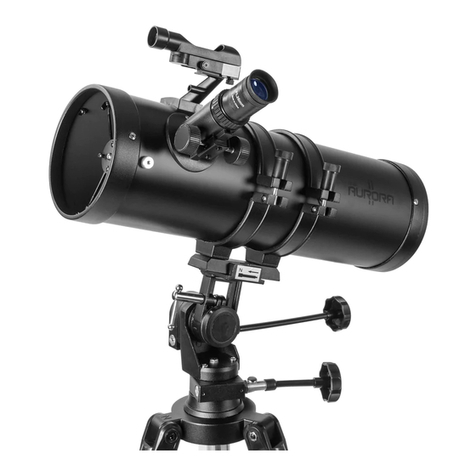
Explore One
Explore One Aurora II User manual
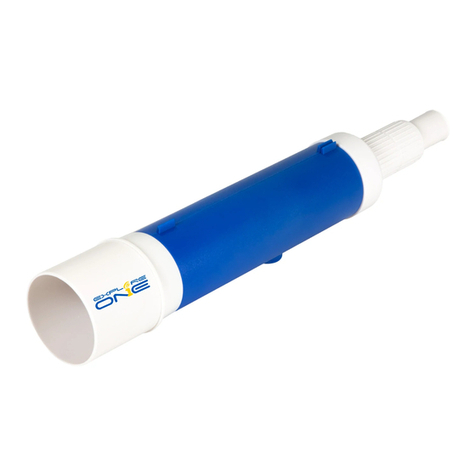
Explore One
Explore One 88-50ERTK User manual
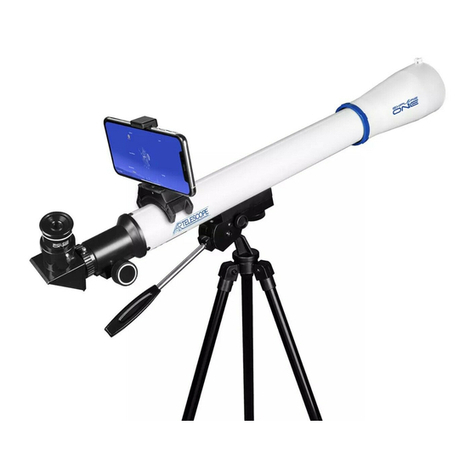
Explore One
Explore One STAR50APP User manual
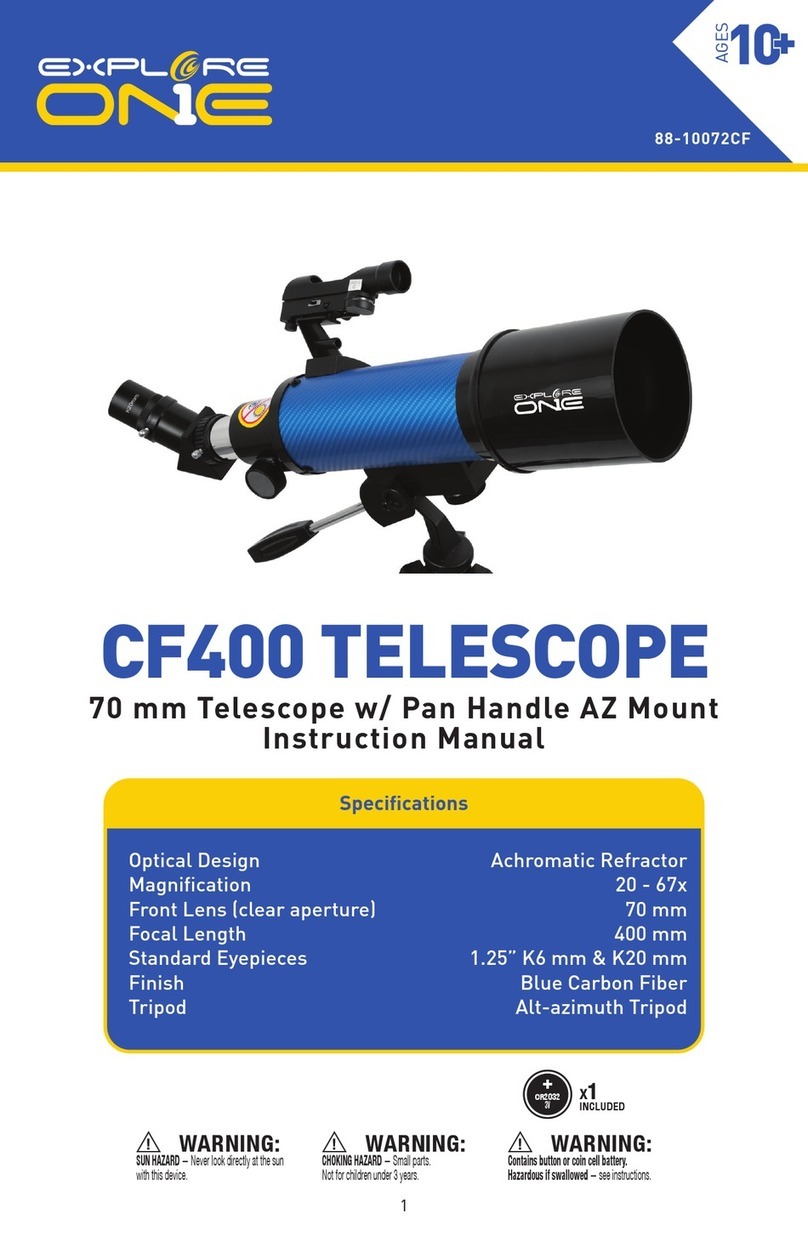
Explore One
Explore One CF400 User manual
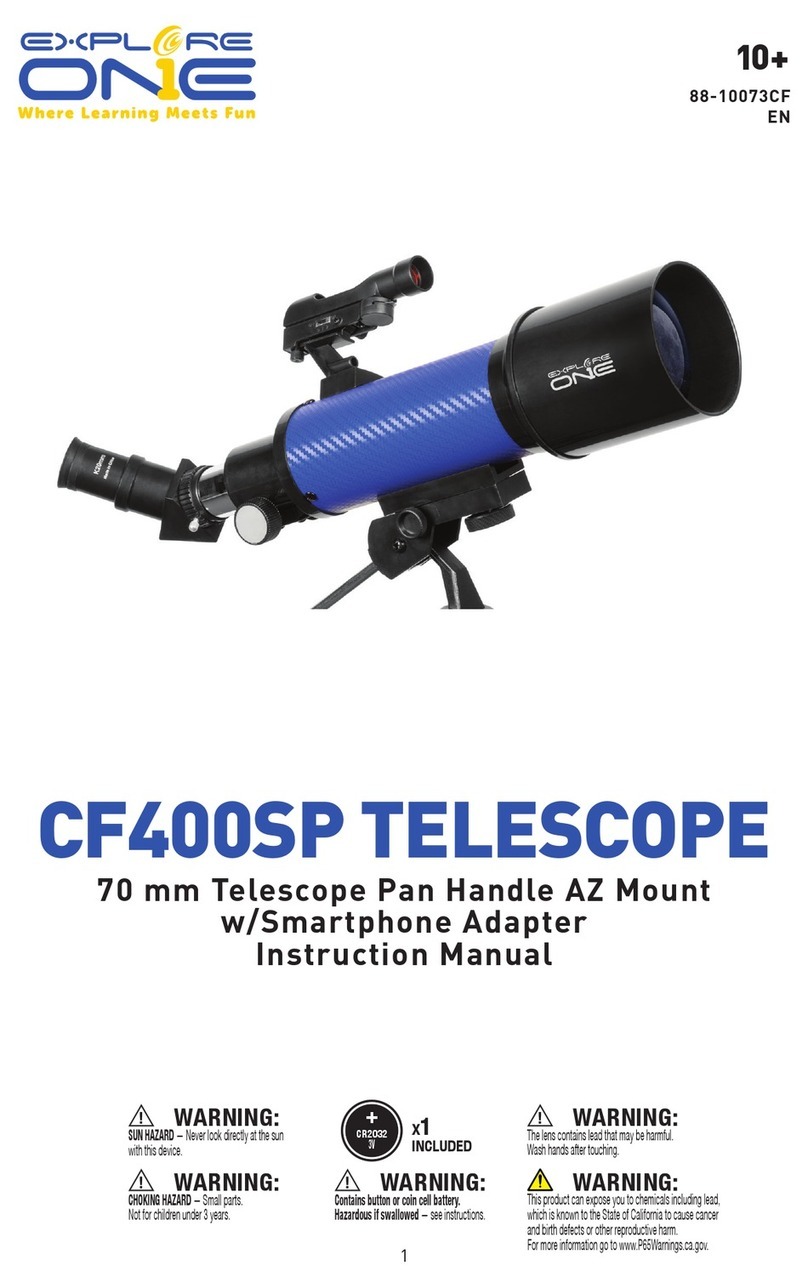
Explore One
Explore One CF400SP User manual

Explore One
Explore One CF400SP User manual

Explore One
Explore One CF600 User manual
Popular Telescope manuals by other brands
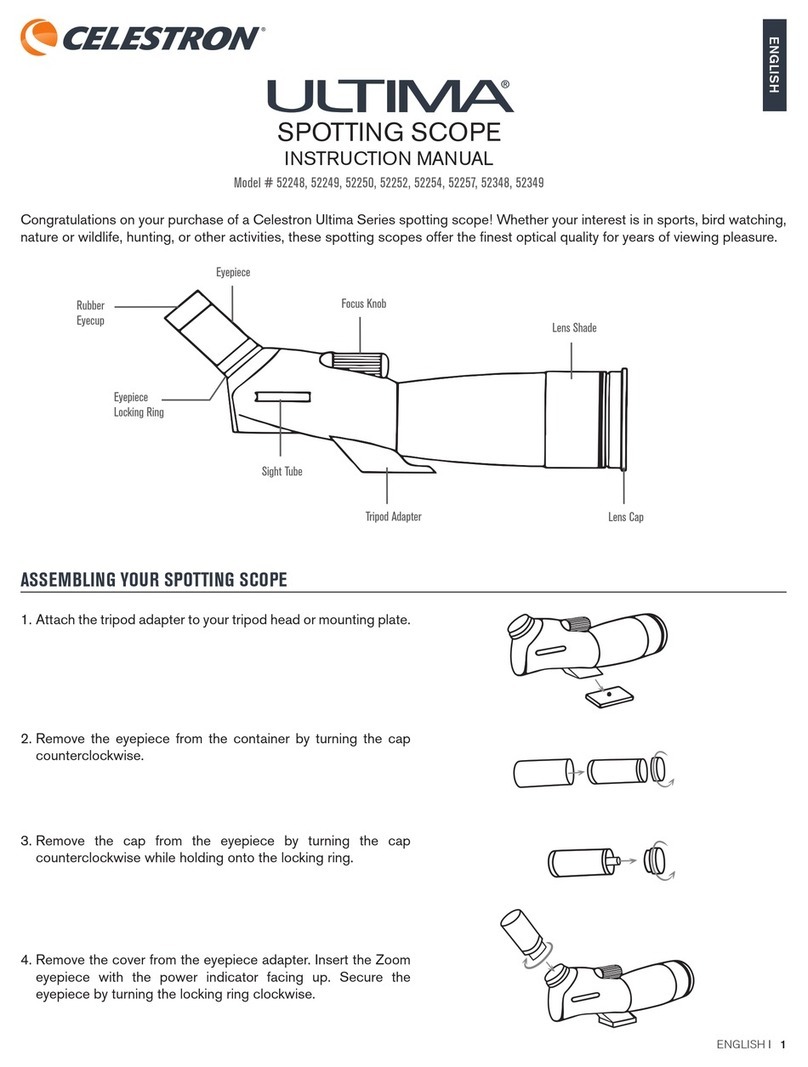
Celestron
Celestron Ultima 52248 instruction manual
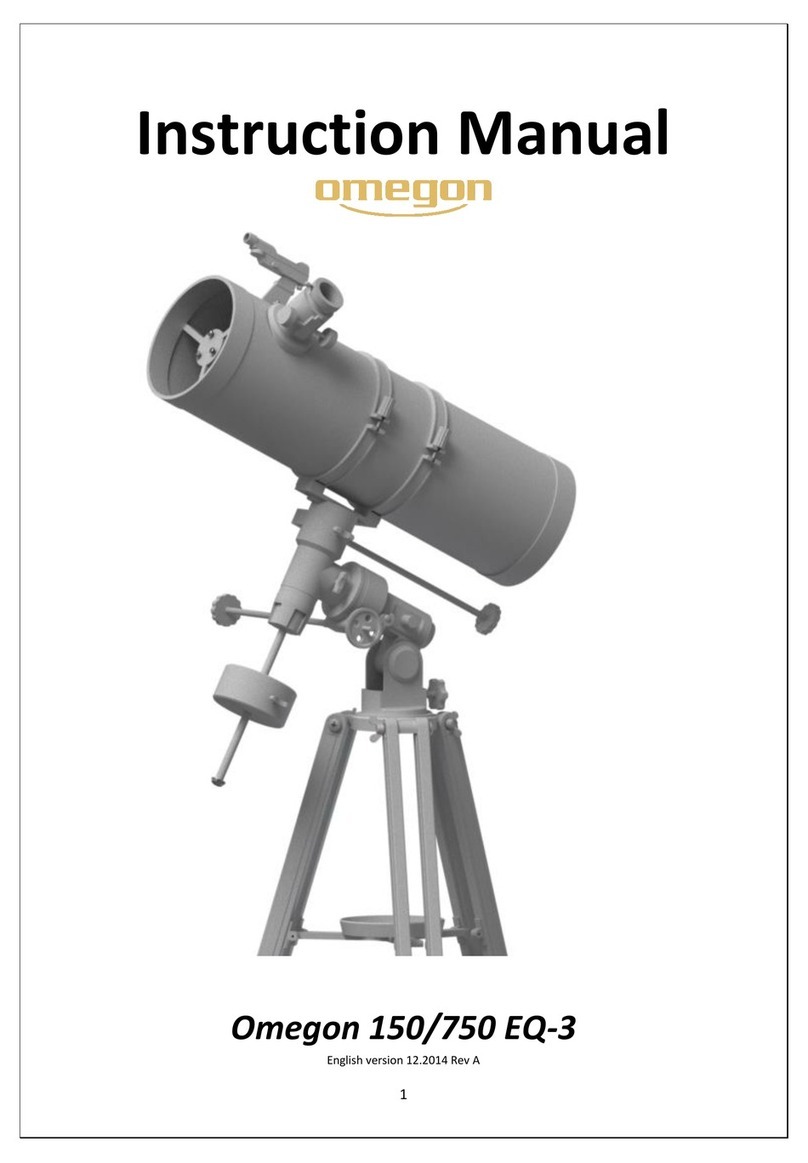
Omegon
Omegon 750 EQ-3 instruction manual
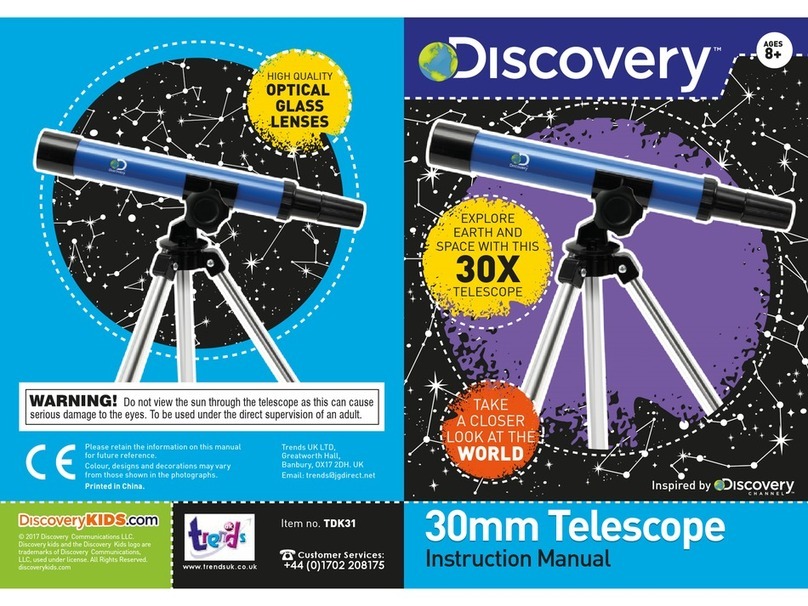
Discovery Telecom
Discovery Telecom TDK31 instruction manual
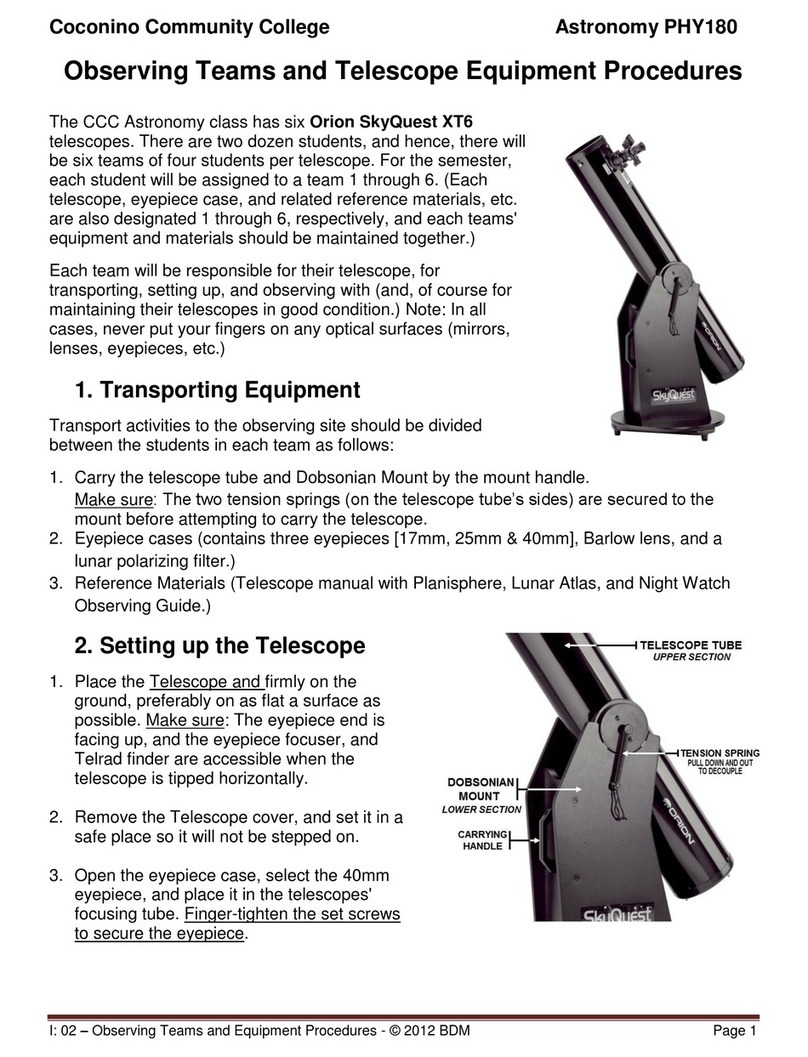
Orion
Orion SkyQuest XT6 IntelliScope quick start guide

Bresser
Bresser Classic 70/350 instruction manual
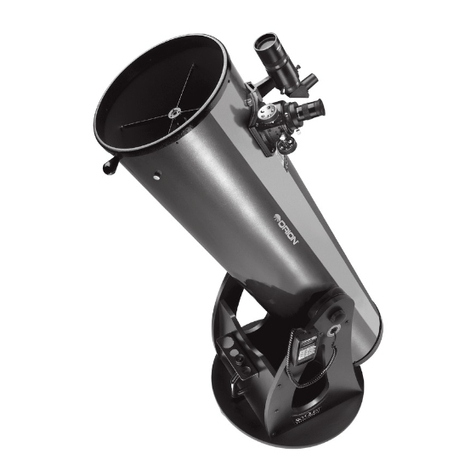
Orion
Orion SkyQuest 10135XT12g instruction manual

